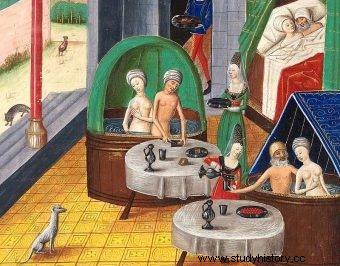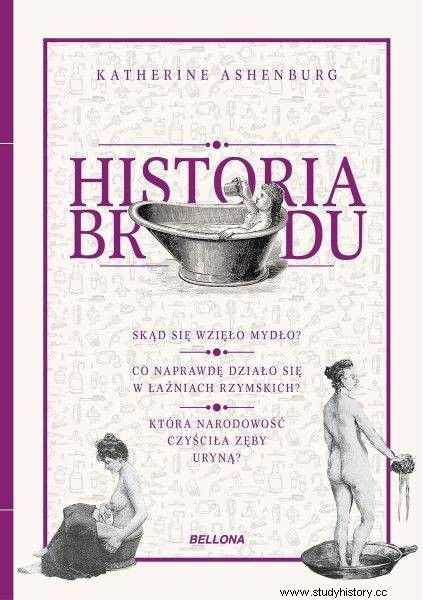Were women in the middle ages overgrown with dirt? Those pious yes! In a letter to Bishop Altino Heliodor, St. Jerome made his famous comment:“Is your skin hard and flaky because you are no longer taking a bath? Once baptized, it is not necessary to bathe again. " Thus, a thick layer of religious impurities was deposited on the bodies of devout Christian women.
The Fathers of the Church thundered not to pride themselves on the qualities of the body and not to expose the soul to condemnation, directing their criticism primarily at women. Instead, it was possible to sin with chastity if you professed the faith of Moses or (horror!) Of Muhammad.
Bath? Over my dead body!
Medieval Christians saw dirt as a method of getting closer to God. In Poland, St. Kinga, who after the death of her husband lived in Stary Sącz in the convent and did not bathe, for reasons observed in women's convents, did not wash her sinful body. Sometimes she washed her face, hands and, at best, her neck. Washing below the collarbones was unacceptable and bathing was a grave sin.

Were the women of the Middle Ages overgrown with dirt? The godly ones!
"Many early saints cultivated dirt with enthusiasm, fervor, and incredible ingenuity," reads in A History of Dirt by Katherine Ashenburg . "St. Agnieszka never stained any part of her body with water during her short thirteen-year life. Godric, an English saint, walked from England to Jerusalem without washing himself or changing his clothes. [...] St. Francis of Assisi worshiped dirt, and even after his death, he would appear to his brothers to congratulate them on their neglected cells. "

Saint Kinga avoided bathing towards the end of her life.
An even more drastic example is the story of the martyr Thecla, condemned to death for resisting advances. She then threw herself at the sharks to be devoured with the cry of "Here is my bath time!" .
And yet the ubiquitous "odor of holiness" did not have to be pleasant to everyone - even the saints themselves understood it. St. Thomas Aquinas (c. 1225–74), who, as an infant, accompanied his mother to the bathhouse in Naples, where he did not allow himself to be thoroughly washed by the nurse, because he clutched a prayer to the Virgin Mary in his hand, recommended the use of incense in the church to suppress the stench of crowded bodies, because - as he himself admitted - "it can arouse disgust".
After marriage, can you venture?
The ritual bath was an exception to the strict prohibitions. In the Life of St. Catherine of Alexandria we read how Jesus commanded the saint to wash the body clean in preparation for a mystical marriage, and the Mother of God added that every lady before marrying a "prince or king" should take a bath, "to become sweet and clean, otherwise greatly offend him maybe ”.
After the wedding night, it was easy to venture into it - unless the woman belonged to the Mosaic religion. Of all medieval Western society, married Jewish women before the menopause showed the greatest care for cleanliness. A monthly, extremely thorough ritual bath was required in the mikveh, or bathhouse, after the end of the menstrual period, rendering the woman unclean.
Niddah , as a menstruating woman was called, there was an order to purify in a ritual bath, the so-called mikveh, seven days after the end of bleeding. Only then could she have sexual relations with her husband. […] The cleanliness of the women using the mikveh resulted not so much from the ritual bath itself, but from the obligatory initial washing that preceded it. Niddah had to be physically spotlessly clean, including her hair and nails, when she entered the ritual bathhouse, so that nothing was between the mikveh waters and the body of the bather.
Except for periods of pregnancy and lactation (and the recommended return to sexual activity in the middle of the monthly cycle must have resulted in a high percentage of them) and cases of infrequent menstruation, the woman performed at least twelve thorough ablutions per year - which is an impressive number for those times.

The text is based on the book by Katherine Ashenburg "The History of Dirt", which was published by Bellona publishing house.
Muslim women also took care of cleanliness, being a contrast to neglected, though devout, Christian women. In the Book of the Thousand and One Nights written at the turn of the 9th and 10th centuries, the Arab gardener emphasizes that both Christian men and women:"never wash themselves because, at birth, gloomy men in black robes pour water on their heads, and this ablution, accompanied by bizarre gestures , it frees them from the obligation to wash themselves for the rest of their lives. ”
Just like Muslim women enjoyed hanging out in hammams , so also Jewish women used the bath more often than indicated by the religious rules. One rabbi of the Ashkenazi community in northern France and the Rhineland complained that women made bathing a "regular practice," far more careless than the meticulous cleansing prior to entering the mikveh. Here the great religions of the Middle Ages meet, because the Christian bishops likewise complained about the inclination of Christian women to visit the baths.
Dirt, hunger and scandal
The ladies of Carthage who lived in the 3rd century came into conflict with their bishop, Cyprian, who forbade them to use the city baths, arguing as follows:"Let everyone be careful about the intentions with which he goes to the baths, my only concern is to refresh and wash my poor body ”.
Athanasius, Bishop of Alexandria, in Second Letter to the Virgins He compared women to doves associated with cleanliness and persuaded them to be satisfied with washing in a bowl, similar to these birds. In his opinion, lovers of spending time in the baths "not only suffered the same damage, but they also spoiled others many times".

Athanasius, bishop of Alexandria, compared women to doves associated with cleanliness and persuaded that, like these birds, they should be content with washing in a teddy bear
Church fathers often said that it was easy for women who were too devoted to hygiene to lead men astray, citing the story of the biblical Bathsheba as an example. The aforementioned Athanasius, just in case, advised women to give up bathing completely, and if you do have to wash yourself, you should do it modestly, preferably in cover .
Medieval theologians and preachers saw washing the body as a source of sin and scandal to such an extent that even seeing one's wife bathing or having a spouse bath together was a sin. By an edict of 475, Pope Boniface forbade taking baths with a person of the opposite sex, and a later edict directly condemned such an act. In the 11th century, they did penance for this terrible deed ... with a three-day fast.
Apparently, a bath could only be innocent, and even pious, when you washed… someone else. St. Radegunda, the 6th-century Queen of the Franks, washed the lepers and the poor in tubs every Thursday and Saturday. Later saints did the same, as was exemplified by Elizabeth of Hungary, who lived in the 12th century. Where does such a paradox come from? Let us give the floor again to the author of The History of Dirt:
Olympia, Radegunda and other saints though they mortified themselves, realized that not everyone must and can follow their path . For ordinary Christians, the purity of the body was a blessing, bringing relief, well-being, and improved health. Humility and mercy required the most immaculately dirty saints to help others achieve a state of cleanliness.
Learn more:Hygiene of medieval queens. Did our rulers stink?
Clean "Venus's room" and a bath for eggs
In the middle ages, the relationship between a woman's external beauty and her spiritual qualities was very complicated. Spiritual purity was certainly important to medieval ladies, but chastity had a different dimension. The concepts of courtly love and chivalry, valid in the upper classes, made the degree of attractiveness of both women and men dependent on personal hygiene.
Authors of a masterpiece of ancient French literature of the thirteenth century, composed of two completely separate parts The Novel of the Rose, William of Lorris and Jan of Meun , they appealed:"You must abhor all dirt." Neglect was met with stigma and even the most beautiful ladies could not count on a wreath of admirers if they were at odds with personal hygiene . Interestingly, the hygiene of intimate places and epilation should not be neglected, as we read in The Novel of the Rose :"Let him, like a polite girl, keep the House of Venus clean."
In the writings of Trotula de Ruggiero, a semi-legendary medic from the 12th century, namely in De ornatu mulierum devoted to care, you can find, among others a description of the benefits of bay oil that women could use on their feet and intimate areas to improve their odor. Fennel, lovage or chewing parsley were great for fresh breath. The multitude of advice on hair and skin care could surprise many a modern blogger.

Illustration from the Medieval Manuscript of The Novel of the Rose
Also the author of Liber Simplicis Medicinae sive Physica - Hildegard of Bingen, a 12th-century German visionary, healer, herbalist and mystic, although she did not leave any specific cosmetic recipes for her posterity, included many valuable tips in this field in her treatises. For example, she emphasized the regenerating and nourishing properties of oils of plant and animal origin, and the sources show that the body and face liniments of that time contained ingredients such as olive oil and almond milk, which are also fashionable today.
The body was also rubbed with eggs or honey, which was also recommended by Trotula to all ladies who wanted a whiter shade of complexion. In the accounts of the court of Władysław Jagiełło and queen Jadwiga, there is a record that on May 10, 1389 in Niepołomice, 30 bathing eggs were issued for court maids ( ad balneam domicellabus ) for 12 denarii. This practice was ridiculed by one of the first Polish ethnographers, translator and diarist Łukasz Gołębiowski (1773–1849):
Stupid, something has wiped it off,
You'd better eat them
Or this separate glowing honey.
Perhaps the ladies of the court of Queen Jadwiga, as well as herself, liked baths more often than was considered decent. The end of the era and the period after the Crusades, from which the crusade participants brought the habit of bathing in baths, changed the approach to cleanliness. In Europe at that time, baths sprang up like mushrooms, and in many countries the taste for lingering in the bath was so strong that it scandalized visitors.
The Germans and Swiss were said to be the most free in this regard. In 1414, the Florentine writer and collector of manuscripts, Gian-Francesco Poggio, went to the Swiss baths in Baden, near Zurich, from which he reported shocked: "They go to bath three or four times a day, spending most of the day singing, drinking and dancing. (...) And the view is captivating:young girls, already ripe for confusion, full of alluring shapes, and with noble faces, standing and moving like goddesses. "
In turn, the fourteenth-century Krakow had 12 city and private baths ( balneola ), which were located in brick buildings with access to a water supply, offering changing rooms and separate bathing rooms for women and men. How often were they visited? In fact, it was possible every day (except on Sundays and holidays), but there were probably many who could endure a bath once in a while. Well, in that respect, society hasn't changed much in the last few centuries…
This article was inspired by the book A History of Dirt by Katherine Ashenburg , which was released by the Bellona publishing house.
Literature:
- Bukowczan-Rzeszut, A., How to survive in medieval Krakow, Krakow 2017.
- Eco, U., Art and Beauty in the Middle Ages, Krakow 1997.
- Le Goff, J., Medieval Man , Warsaw 2000.
- Le Goff, J., Truong, H., History of the body in the Middle Ages , Warsaw 2006.
- The Trotula: A Medieval Compendium of Women’s Medicine , edited and translated by Monica H. Green, University of Pennsylvanian Press, 2001.
- Verdon, J., The Pleasures of the Middle Ages, Warsaw 1998.
- Vigarelo, G., Clean and dirty. Body hygiene from the Middle Ages to the 20th century , Warsaw 2012.
- William of Lorris, Jan of Meun, The Novel of the Rose , Warsaw 1997.
